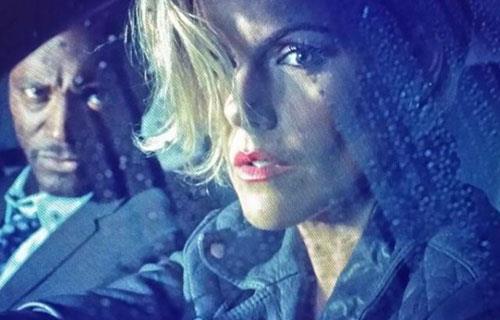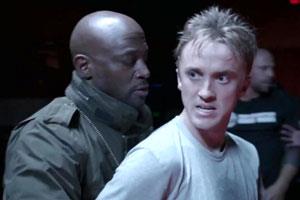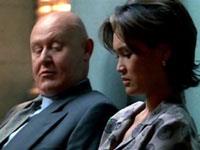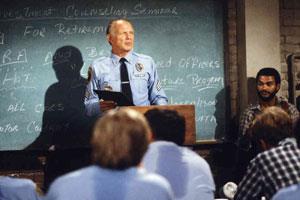
[Editor's Note: TVWW contributor Donna J. Plesh died April 2, 2015, from ovarian cancer. She was 71. Donna covered television since the early 1980s, initially for the Orange County Register and its TV magazine. She also was a member of the Television Critics Association. Donna was always a cheerful spirit within the TVWW network and often gave readers a kind, up-close viewpoint in her interviews with a wide variety of television stars. She will be missed.]
Creating a drama series for television is nothing new for Steven Bochco. He’s been doing it for decades — Hill Street Blues, NYPD Blue, LA Law and Murder One to name but a few. Now he’s back, with TNT's Murder in the First...
 Premiering Monday, June 9 (10 p.m. ET), and set in San Francisco, TNT's Murder in the First follows homicide detectives Terry English (Taye Diggs) and Hildy Mulligan (Kathleen Robertson) as they investigate two seemingly unrelated murders over a 10-episode story arc. The mystery deepens when they find both murders have a common denominator in a high-powered Silicon Valley executive, played by Tom Felton (with Diggs at right).
Premiering Monday, June 9 (10 p.m. ET), and set in San Francisco, TNT's Murder in the First follows homicide detectives Terry English (Taye Diggs) and Hildy Mulligan (Kathleen Robertson) as they investigate two seemingly unrelated murders over a 10-episode story arc. The mystery deepens when they find both murders have a common denominator in a high-powered Silicon Valley executive, played by Tom Felton (with Diggs at right).
While trying to solve the murders, both detectives are dealing with personal problems. Diggs' Terry has a terminally ill wife, while Robertson's Hildy is a single mom trying to juggle a job and family life. The cast also includes Steven Weber, Richard Schiff, Raphael Sbarge and Mimi Kirkland.
Granted, much change has come to television in the decades since Bochco’s first TV hits, with perhaps the biggest being the number of episodes given some hour-long series. Back in the days of his previous drama series, series normally received orders for 22 to 24 one-hour episodes. Now many cable and some broadcast network series are coming in with anywhere from 10 to 12 episodes for a season.
“I clicked on [Murder in the First] when Michael Wright [president, head of programming for TBS, TNT and Turner Classic Movies] asked me to, because the basic concept for Murder in the First was suggested to me by Michael," Bochco said during a Television Critics Association press tour interview promoting his upcoming series.
 "I instantly sparked to it because it’s a comfortable arena for me and it’s the kind of storytelling I like to do and I’m always challenged by. When we did Murder One (seen at right) — 22, 23 episodes — whatever that season was [its Season 1 continuing mystery story premiered on ABC in 1995, and ran for 24 episodes], we were halfway through and I didn’t know how it was going to end, which was a little intense. And you do get to the point where, over that many episodes, you are really struggling to make every hour sustain itself in the service of a single story line.
"I instantly sparked to it because it’s a comfortable arena for me and it’s the kind of storytelling I like to do and I’m always challenged by. When we did Murder One (seen at right) — 22, 23 episodes — whatever that season was [its Season 1 continuing mystery story premiered on ABC in 1995, and ran for 24 episodes], we were halfway through and I didn’t know how it was going to end, which was a little intense. And you do get to the point where, over that many episodes, you are really struggling to make every hour sustain itself in the service of a single story line.
"Ten episodes or 12 episodes, you know, seem to me to be an ideal length for this format. It really eliminates the necessity of filler. You know, you can really serve the story, serve the characters, and it also gives us much more time to think about what we are doing and to craft our script.”
Bochco series have been largely absent from the small screen in recent TV seasons, since such dramas as Over There in 2005 and Raising the Bar in 2008, and he has an easy explanation why.
“I’m just old. So, you know, I’m hanging around. Fortunately my friend, Mr. Wright, rescued me from obscurity. You know, the business changes. And I’m only half kidding when I say I’m older, and I don’t actually have the drive to work the way I used to work. And so working with these people in this kind of an environment really suits me very well.
"And as the business changes you know. I used to have a professor who remained a very great friend of mine, and who is now well into his 80s, and he said, ‘The weird thing about being a teacher is I keep getting older, and my students are always the same age.’ And the same kind of goes for television. The audience kind of remains the same age. The people you deal with professionally tend to remain the same age. I remember when I used to be the youngest guy in the room and now I’m the oldest guy in the room. So, as times change, you change with it,” he said.
Murder in the First is a cop show, but there are more elements to it, said Bochco, who is co-creator of the series (with TV newcomer Eric Lodal). “Keep in mind that per Michael Wright’s mandate for this show, this is really not just a cop show. It’s a cop show, it’s a legal drama and then it’s a courtroom drama. And so what we’ve tried to do is to pretty much encompass the whole of the criminal justice system.
"And San Francisco is a wonderful choice for that, because the entire criminal justice system in San Francisco resides in this one giant building at 850 Bryant Street, and so there’s a real nice symmetry to all of that. So we don’t think of ourselves as being strictly a cop show. It’s legal drama. It’s a courtroom drama. And this show dramatizes, I think pretty effectively, the way in which all of those elements of the criminal justice system interface,” he said.
With today's television drama series drawing big-name writers, directors, producers and actors who, in the past, were strictly involved in theatrical movies, Bochco feels that television drama has become a go-to destination for these talented professionals, sometimes more so than big-screen films.
 “I think what we did with Hill Street Blues in the early 1980s, and then the shows that its success spawned, including a few more of my own, just opened up the world. I don’t want to say we made Hill Street Blues with that intention, but it became very clear to us when we survived the first year of that show, that we were showing an audience of viewers a different way to watch and appreciate television, and for those of us involved in it at the time it really was the first time, at least in my career, that people were proud to say, ‘I’m a writer in television.’
“I think what we did with Hill Street Blues in the early 1980s, and then the shows that its success spawned, including a few more of my own, just opened up the world. I don’t want to say we made Hill Street Blues with that intention, but it became very clear to us when we survived the first year of that show, that we were showing an audience of viewers a different way to watch and appreciate television, and for those of us involved in it at the time it really was the first time, at least in my career, that people were proud to say, ‘I’m a writer in television.’
"So I think all of us who were intimately involved with the show —David Milch, Tony Yerkovich and all of us — did have the sense going forward that we were certainly aware of advancing the agenda, if you would.”